How to move a storage shed in theory and practice
Wondering how to move your storage shed? This article covers everything from the basics of moving a shed across your yard, to more advanced tips for moving your shed across town.
Moving a storage shed can sound intimidating but there's no need to feel that way. In this article I will provide you with all the information you need to move your shed in theory and practice.
I have included some pictures from shed moves I have done to demonstrate what I talk about. I also have some sketches to illustrate other techniques that I have up my sleeve for when the opportunity presents itself.
I will show you how to move your shed with little bit of planning and some muscle power.
First, we'll discuss some of the reasons why you might want to move your shed
The need to move a shed to a new location in your yard is surprisingly common. Needs change over time and when a back yard is remodelled a shed can just be in the wrong place.
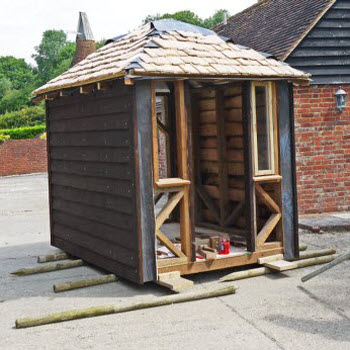 Moving a shed across the yard
Moving a shed across the yard
Other reasons include poor drainage. it occurs sometimes that an issue with very wet ground can come to light and the only solution is to move the shed to a new position where the shed will suffer less damage.
Aside from these issues occasionally sheds are mistakenly build in the wrong position. The shed may have been built in contravention of necessary permits, be built with the incorrect setback or over gas lines. In which case the shed needs to be moved to avoid potential penalties.
Resolving the above issues usually involve just moving the shed across the yard to a new position.
But it may be that you need to move a shed further afield.
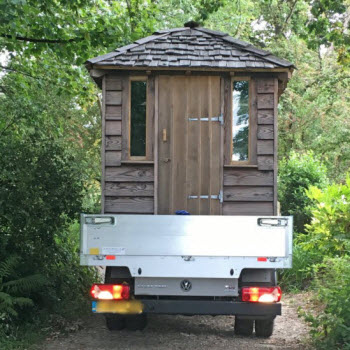 Moving a shed across town
Moving a shed across town
You may be interested in buying a used shed and working out the best way to move it from the vendors yard to your own property.
It may be that when you decide to move to a new home, it can make sense to take your shed with you. This type of situation will require a bit more specialised equipment but moving a shed across town is something that happens with surprising frequency.
Professional Shed Movers
Many sheds in the United States are designed to be moved, as they are designed to delivered already assembled. The shed is built in the constructors yard and then professional shed movers transport it to site in one piece on the back of their flatbed truck.
Once at the homeowners location the shed is off loaded on to the front of the lot. A pair of wheels is installed on the back of the shed. A superb piece of specialized equipment called a 'mule', then lifts up the front of the shed and pulls the shed to the desired location. A shed moving mule is highly manoeuvrable and can push and pull the building into its final resting place on a pre-prepared concrete foundation or area of compacted crushed stone.
This type of operation is quite specialised. The operators have to be very spacially aware and understand how such a large object will behave over lumps and bumps. They also to make a survey of the route beforehand to make sure the route isn't obstructed by powerlines or tree branches.
Anyway that is enough of why you might want to move your shed.
Techniques to move your shed across the yard
To move your shed across the garden doesn't require years of experience. The basic technique is to lift the shed so that you can get some rollers underneath. The shed can then be relatively easily, possibly with the help of a few family members, pushed along. Very much in the same way that the Ancient Egyptians moved huge stone blocks to build the pyramids using only simple tools. In the next few paragraphs I will cover the principles you will use.
What is the best way to lift the shed?
The very simplest way to lift a shed is to use a lever. By placing a fulcrum close to the shed you can magnify your body weight so that one corner of the shed can be lifted enough to put a concrete block underneath. This can then be repeated at other corners of the shed so that the shed is supported concrete blocks and the rollers can be placed underneath. The lever is then used to gently lift the shed so the blocks can be removed and the shed lowered on to the rollers.
More controlled methods of lifting a shed involve using mechanical and hydraulic jacks. Types of jack that you can use include:
- Hi-lift jack
- Floor jack
- Hydraulic bottle jack
Although sheds seem heavy, in contrast to the type of loads that commonly used jacks are used for you won't need a hugely specialised heavy jack. Though having just said that I would steer you clear of using the scissor jacks that are some times supplied with cars. When using this type of jack, if the load isn't perfectly centred and supported the jack can become and distort sideways. This may ruin your day!
What types of roller to use when moving a shed?
There are a few commonly available things that you can use as rollers to move your shed.
- Scaffold tube or metal pipes
- wooden peeled logs
- pvc pipes
The choice of each will partly depend on what you have to hand or can easily get hold of. The other factor to consider is the type of ground that you will be moving the shed over. If the ground is rough then scaffold tube may be too small a diameter to cope with stones. If you are moving a large shed then you may struggle to get peeled logs long enough. In which case upvc may be the best option. In many cases people do find these lightweight pipes often the type that are used on gas lines the best option.
If you are moving your shed over rutted or soft ground you may also want to use some timber planks, scaffold boards or lengths of old conveyor belt to make a path way for the rollers to run on. This is a bit of extra work in the move but well worth it in the effort saved.
How hard is it to move a shed on rollers?
It really is surprisingly easy when you are moving a shed on a level, smooth surface. If you want to move the shed downhill it may be that you need to be in front of the shed to stop it moving too fast. If you are moving a shed uphill then more oomph is required and you may need a cable winch or some other type of mechanical pulling device. Some people use a winch on the front of a pick up truck or even a lawn tractor to provide the power.
Are rollers really necessary?
Some sheds built on skids can be pulled along by a small tractor without using rollers at all. This method will put more stress on to the shed structure due to the rougher ride and also leave some nice slide marks on your lawn, driveway.
Is there an alternative to rollers?
One alternative to rollers is to use wheeled dollies that can be fixed to the skids at the back of the shed. To install these you lift the back of the shed first to install the wheels.
Then lift the front of the shed and install the remaiining wheels or use the lift bar of a tractor.
Those are the basic building blocks for moving your shed. Let's put them together to see how it all works
Moving a storage shed step by step
The first thing is to empty out the contents. The shed is already heavy enough without all your clobber inside!
The next thing you'll need to do is to prepare your storage shed for moving. It's no good just dragging it across the yard without strengthening it first. Attach wooden braces to the studs for added stiffness. Pay particular attention across door and window openings. Any distortion in the window frame may crack the glass or weaken connections in the frame of the building. If the shed floor is made of floorboards this will require stiffening as well. Make an X-shaped brace across the floor as a plan brace to prevent the floor 'racking' as the shed is being moved.
The next step to moving a storage shed is to lift it at one end so that the rollers can be placed under. For a small shed, pass a rope or length of nylon webbing beneath the shed. The shed can then be lifted with one, or more, people pulling on each end. When the shed is lifted off the ground a third person can place a roller under the shed.
If you have a larger shed you may need to use mechanical or hydraulic jacks to do the heavy lifting. In the example that follows I used a small hydraulic car jack to lift the shed. If the shed has been in one place for a long time you may need to locally dig around the base to gain access to the corners.
With the shed lifted up, inspect the underside of the floor
If you are moving a shed on skids, that's great the rollers go under the skids. If it is joists and they are running at right angles to the direction of travel then you will need to fit a scaffold board to the underside of the shed, as I did.
Also if the shed has been in one place for any period of time check the condition of the floor timbers. Timber in proximity to the damp ground may have caused some decay and some timbers may need replacing.
Make any structural repairs that are needed so that the shed is in the best shape possible prior to moving it.
Before you start moving a storage shed make sure you've prepared your new shed base. So that it has a nice level foundation to rest on when it arrives at its destination.
Once you've strengthened the frame and lifted the shed you'll find the easiest method of moving it, is on rollers. If you're moving a smaller storage shed, metal scaffolding poles or 4" diameter wooden fence poles are ideal. If you're moving a larger storage shed, you may want to use a cable winch or a truck to pull the shed along.
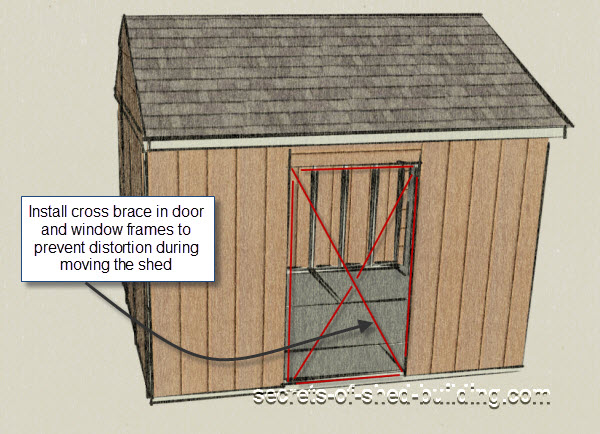 Brace any openings that you need to to keep the frame square
Brace any openings that you need to to keep the frame square
Moving a shed on rollers
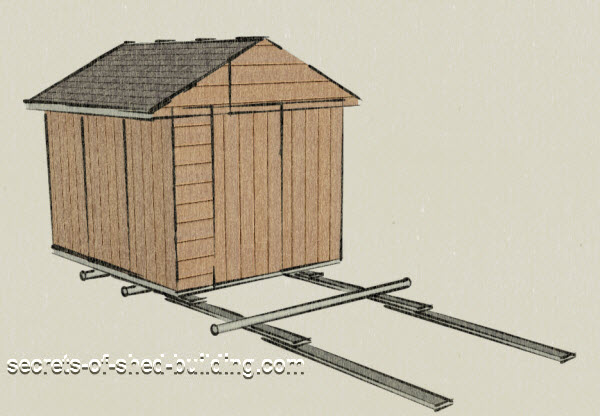 Use rollers and scaffold boards on the ground if you are running on soft grass
Use rollers and scaffold boards on the ground if you are running on soft grass
Moving a storage shed by yourself is possible but it is better to have someone with you to help. In terms of dividing up the tasks I found that having one person who focussed on 'steering' the shed and the other pushing and moving the poles worked well.
Steering the shed was achieved with a scaffold pole to lever the shed in the desired direction.
The other person provided the motive power, by pushing the shed, picking up the poles as they came out from behind and carrying them to the front. So that there was always at least two poles under the shed at anyone time.
You then manoeuvre the shed into its new position, or onto a trailer if it's going to your new home.
How to move a small shed across the yard
I built this shed in a barn and then needed to move the shed out into the yard to its final position. I decided not to completely assemble the shed in the barn to save a little on weight.
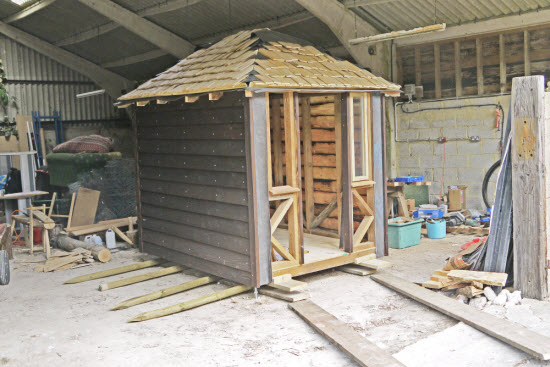 The shed prepared and ready to go
The shed prepared and ready to go
The best strategy for moving a storage shed is to do it 'Egyptian Style' using rollers. The first step was to use a hydraulic car jack to lift up each end of the shed in turn to remove the screw jacks from each corner of the shed.
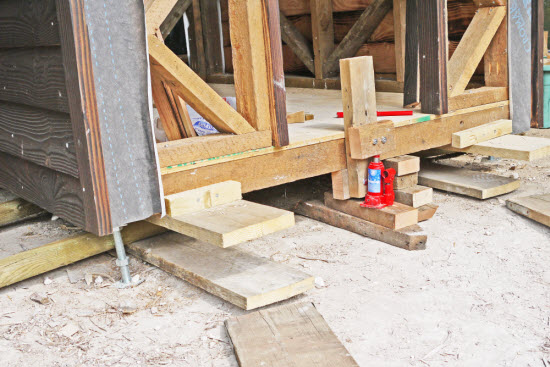 Lifting up the shed to install skids and insert rollers underneath
Lifting up the shed to install skids and insert rollers underneath
The barn floor was of rough compacted chalk so I used some scaffold boards to create a smoother running surface until we got the shed out of the barn and onto the smoother concrete surface of the farmyard. We had to make sure that at least two rollers were under the shed at any one time.
Moving a shed on rollers is surprisingly easily. Possibly the trickiest thing to do is to 'steer' the shed. This was achieved using a scaffold pole to lever the front of the shed into the required direction.
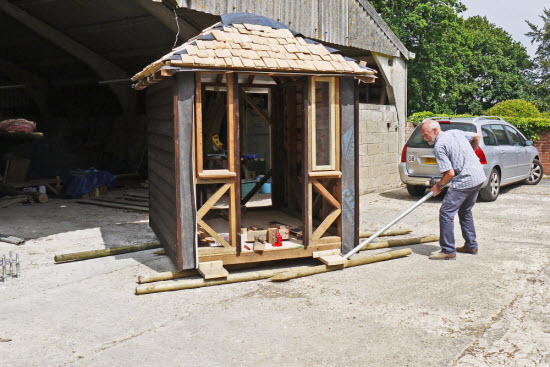 Using a scaffold pole to help steer the shed around a 90 degree bend
Using a scaffold pole to help steer the shed around a 90 degree bend
The general direction of travel was downhill but even moving up a slight incline would have been possible. With one person concentrating on the steering, the other moved rollers from the back as they became free and brought them round to the front.
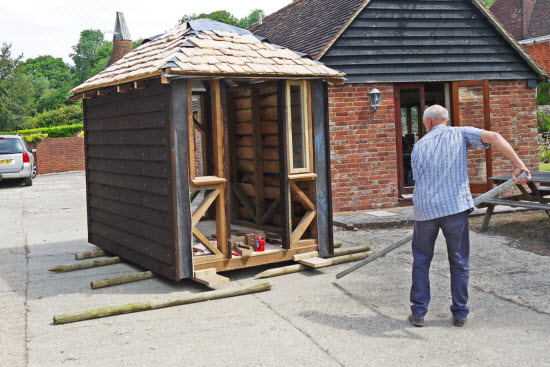 As poles were removed from the back they were carried round to the front of the shed
As poles were removed from the back they were carried round to the front of the shed
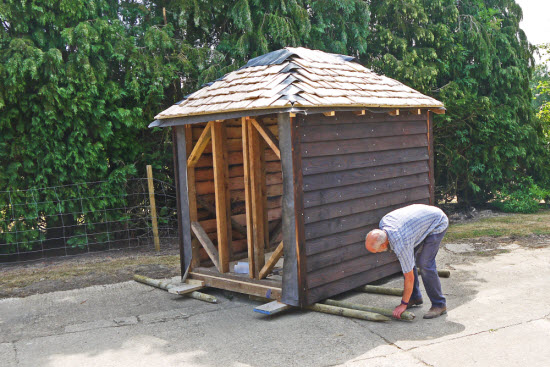 Approaching the final location of the shed
Approaching the final location of the shed
The shed was eventually in its final resting place about 50m from where its construction had started. The jacking process was reversed to lift the front then the back of the shed up so that the screw jacks could be inserted into the base frame and then adjusted for level.
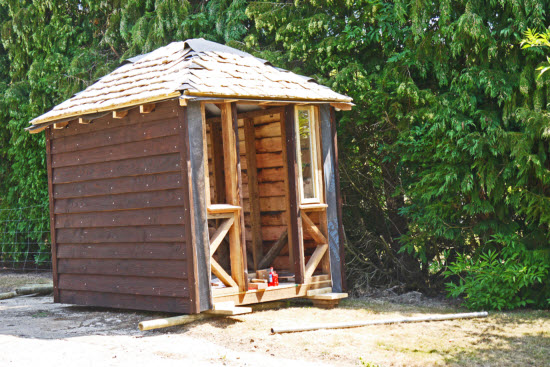 The shed in place requiring final levelling
The shed in place requiring final levelling
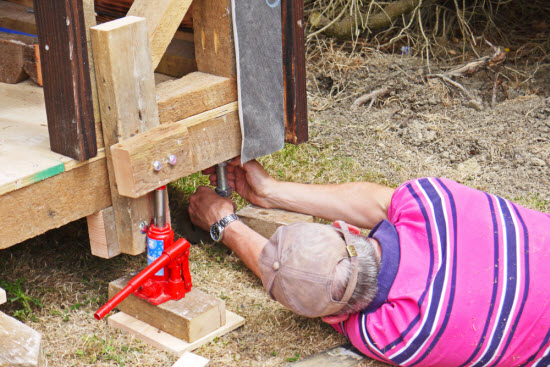 Jacking the shed up to remove the rollers and adjust for final level
Jacking the shed up to remove the rollers and adjust for final level
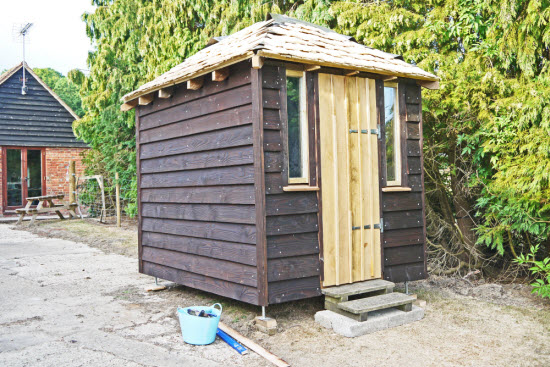 Shed in final position with siding, doors and windows fixed
Shed in final position with siding, doors and windows fixed
This is a great way to move a shed across the yard what if you want to move a shed further afield?
Example 2: How to move a shed across town
I needed to move the same shed to a customers property about 3 miles away. Dismantling the shed would have been difficult due to amount of work involved in the sweet chestnut shingle roof.
The answer was to use a forklift and a flatbed truck to move the shed. The same techniques could be used to lift the shed on to a vehicle trailer. But the size of the truck and shed meant that we had better maneoverability for getting in and out of the entrance of the new property by using a truck (as you will see!).
The estimated all up weight of the shed was in the region of 1,000kg. This was close to the lifting limit of the Avant 745 fork lift loader and the length of forks we had available.
The main strategy that we used in all of this was to minimise the amount of moving the shed on the forklift and also minimise the height and duration of any lift. The reasoning behind this strategy was to minimise the possiblity of damage occuring to the shed due to it becoming unstable and toppling over.
Relocating a shed, step by step
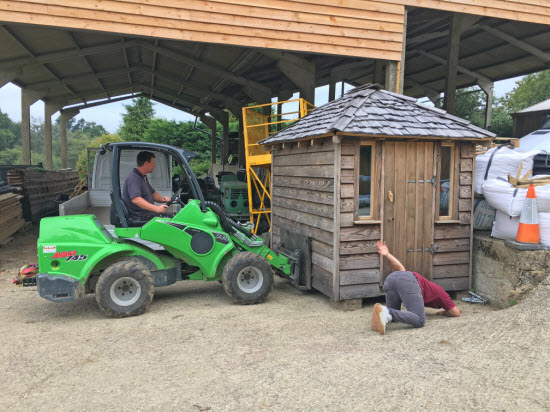 1. Making sure that the load was over the forks.
1. Making sure that the load was over the forks.
A timber spreader was used between the forks and the floor joists to evenly distribute the load into the shed floor.
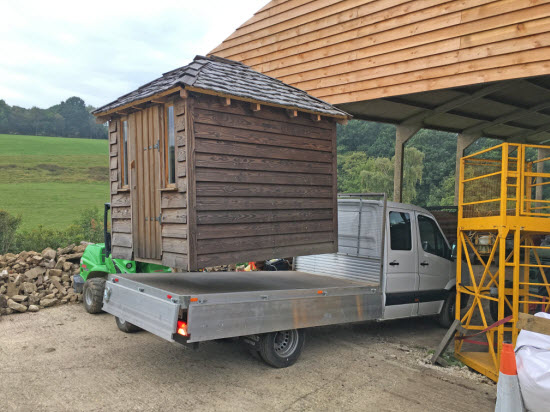 2. The shed was lifted and moved so the flatbed truck could reverse underneath
2. The shed was lifted and moved so the flatbed truck could reverse underneath
Minimising movement of the shed at height on the forklift reduced any chance of it becoming unbalanced.
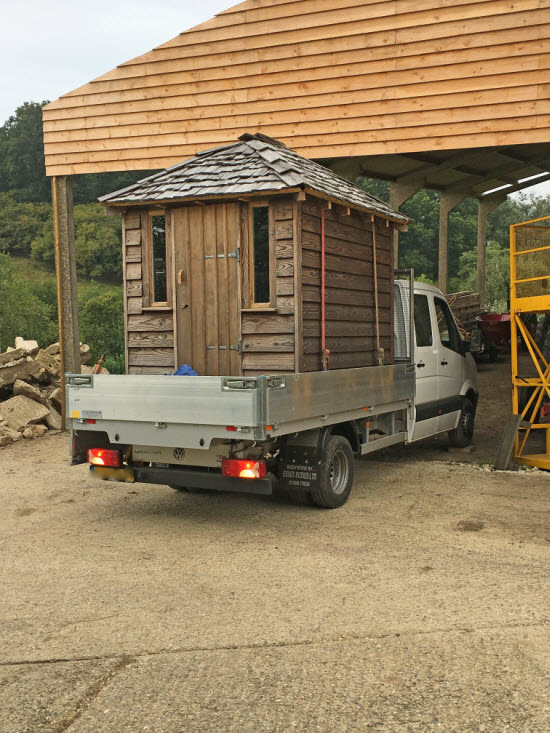 3. Shed loaded on to the truck and secured with ratchet straps
3. Shed loaded on to the truck and secured with ratchet straps
Notice the two straps that hold the shed down. The initial lift showed how 'top heavy' the shed was. Unlike most sheds, which have lightweight roofs, this roof was of solid timber shakes, each 20mm thick and with an average thickness of three shingles it was by far the heaviest part of the shed (and the most beautiful).
The shed was transported along the public highway at a speed of 20-30mph. It had survived gales the previous winter with gusts of 40-50mph so we reckoned the shingles would easily resist the wind load at that speed.
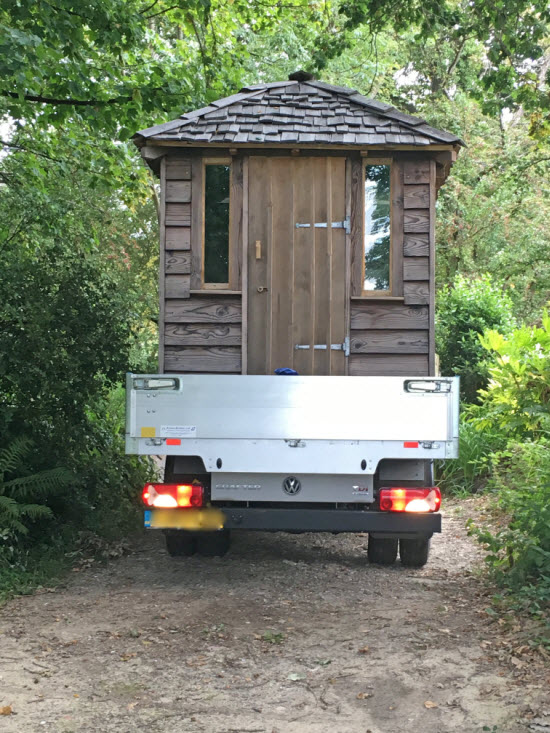 4. Arriving at site avoiding low hanging branches
4. Arriving at site avoiding low hanging branches
A key factor for this project was the accessibility of the garden to vehicles. A bit of reversing was required to get through the gate but after that it was straight forward to reach the concrete pad that the shed was going to sit on.
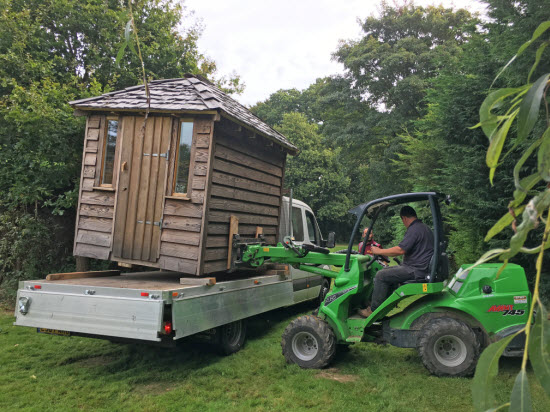 5. The aim was to lift the shed vertically off the back of the lorry, move the lorry out of the way and then slowly lower the shed so
that it was close to the ground.
5. The aim was to lift the shed vertically off the back of the lorry, move the lorry out of the way and then slowly lower the shed so
that it was close to the ground.
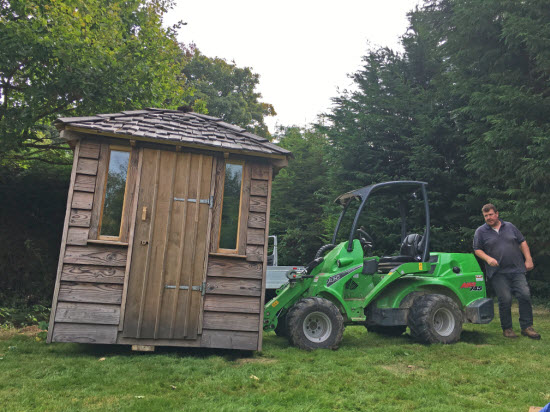 6. With the lorry out of the way the forklift lowered the shed and slowly moved forward.
6. With the lorry out of the way the forklift lowered the shed and slowly moved forward.
You can see that the shed is slightly tilted backwards. This is to keep the centre of gravity of the shed over the forks. The ground was quite uneven and if the forklift lurched forward the shed could have started to tip over. The aim at each step was to move the shed slowly and deliberately.
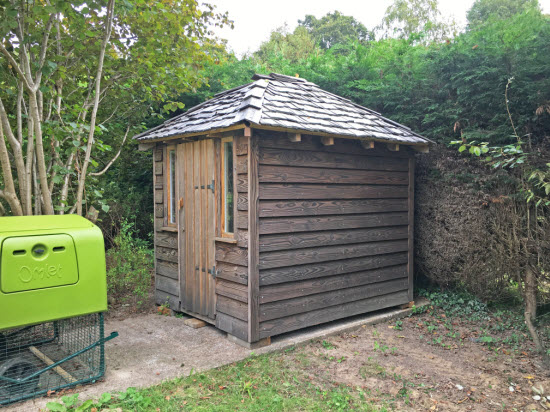 7. A little more jiggling forward and back and the shed was sitting squarely on the concrete pad.
7. A little more jiggling forward and back and the shed was sitting squarely on the concrete pad.
Conclusion
The steps to effectively moving a storage shed across a yard are:
- Empty the shed to minimise the weight
Prepare to move the shed by bracing any panels that aren't already braced
Plan the route. Lift the shed and insert rollers under the shed
Start to move. One person steer, one person push and move the rollers. Communicate
When you arrive at the destination, jack up the shed to remove the rollers and install on the foundation.
Next step:
This was a very clean example of moving a shed:
- This case study shows a similar technique for moving a larger but older shed
- This is the technique to follow if you need to dismantle your shed into its component panels.
- Moving a Shed FAQ - I get asked a lot of questions about Moving Sheds and so I have pulled together a lot of these onto one page for you to browse

Keep in touch with our monthly newsletter
Shed Building Monthly




